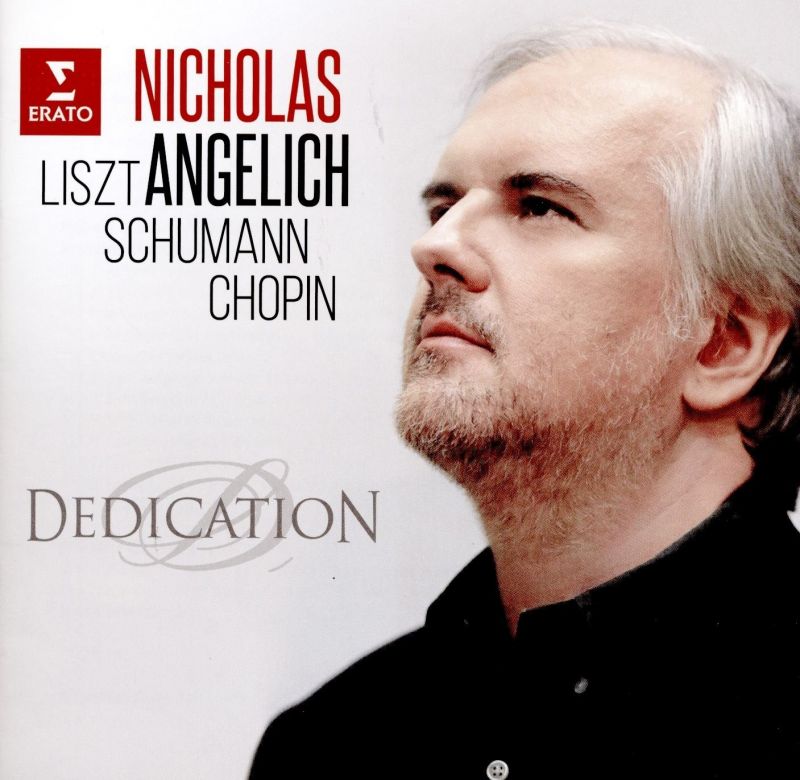Nicholas Angelich: Dedication
View record and artist detailsRecord and Artist Details
Composer or Director: Franz Liszt, Robert Schumann, Fryderyk Chopin
Genre:
Instrumental
Label: Erato
Magazine Review Date: 07/2016
Media Format: CD or Download
Media Runtime: 78
Mastering:
DDD
Catalogue Number: 019029 599067-1

Tracks:
| Composition | Artist Credit |
|---|---|
| (27) Etudes, Movement: A flat, Op. 10/10 |
Fryderyk Chopin, Composer
Fryderyk Chopin, Composer Nicholas Angelich, Piano |
| (27) Etudes, Movement: C minor, 'Revolutionary', Op. 10/12 |
Fryderyk Chopin, Composer
Fryderyk Chopin, Composer Nicholas Angelich, Piano |
| Sonata for Piano |
Franz Liszt, Composer
Franz Liszt, Composer Nicholas Angelich, Piano |
| Kreisleriana |
Robert Schumann, Composer
Nicholas Angelich, Piano Robert Schumann, Composer |
Author: Patrick Rucker
Of the two Etudes chosen from Chopin’s Op 10, Angelich imbues the frolicsome A flat (No 10) with an ardent lyricism that soars with unimpeded joy, without sacrificing anything of its characteristic kinetic buoyancy. The result is arrestingly beautiful. The ‘Revolutionary’ (No 12) recalls the ‘grand manner’ of more than a century ago, with a crisply rhythmical, clarion right hand leading the charge over the churning, roiling ebb and flow of the left hand’s legato perfection.
An aura of confiding intimacy surrounds this Kreisleriana. We are made privy to secrets, touching on troubles and joys, obsessions and aspirations, all conveyed with disarming earnestness and sincerity. Angelich must have lived with this music a long time to inhabit the score so completely. The authentic ring of his rhetorical poise derives from scrupulous attention to Schumann’s phrasing and articulation, within a textured soundscape that seems almost limitless in its variety. When the left hand moves in octaves, it is as though the 16ft stop of an organ has been engaged, creating a firm but whispered reinforcement. Schumann’s famous ‘inner voices’ assume myriad guises, here distant echoes of regret, there blossoming spontaneously from emotional necessity.
Angelich’s artful conception of the conclusion of No 2 seems to suspend time itself. When Schumann urges the pianist to greater and greater speed, as for instance in the cataclysmic finale of No 3 or the fugato of No 7, Angelich always seems to have reserves at the ready. The landscape outside the window may be a blur but the train remains firmly on the rails. During the recitative that introduces No 4, desolation and hopelessness are evoked to chilling effect. As the cycle concludes, with No 8’s crippled figurations skipping beyond earshot, it’s a toss-up between relief from the surfeit of emotional intensity and regret that so vivid an engagement has ended. This is a reading that stands comparison with the most thoughtful and imaginative, Annie Fischer, Argerich and Perahia among them.
The Liszt Sonata is brilliant in both concept and execution. Parenthetically it should be noted that octave passages are even faster and more accurate than Horowitz’s 1932 account. But dazzling octaves do not a successful B minor Sonata make, and here they are but one feature of a spacious musical topography. The defining architectural elements contributing to this mighty edifice are subtly sculpted phrase shapes, vivid contrasts of texture and articulation, and an unerring sense of dramatic thrust.
Gossamer figurations at 9'20" take flight, shimmering with prismatic colour. Angelich’s cunning transition away from the molten rhetorical assertions of the first movement maintains ominous portent, even as its energy dissipates. Arrival at the Andante sostenuto could be the first glimpse of another world, heretofore unimagined. Its profound quiet and calm are breathtaking in their tranquillity. The fugue begins as a sly insinuation that quickly gathers strength, with keenly honed edges that call to mind the lustrous clarity of quartz crystal prisms bursting randomly from their geological matrix.
One may nitpick, of course. The tricky question of the hierarchy of beats within a measure has special implications for the B minor Sonata’s opening statement: should beats two and four receive identical emphasis? And what of trills in an espressivo context? Does a long, uniformly fast trill, like a whirligig held out the window of a fast-moving automobile, really fit the bill?
But these questions seem quibbles in the face of so compelling a reading. Angelich’s magisterial virtuosity is uniquely contemporary, even as his imaginative grasp easily encompasses a persuasive vision of the 19th-century ethos. One could speculate that his stance of heroic nobility is but a short step from what the declamations of Talma and Bocage might have been on the stage of the Comédie-Française, his poignant lyricism not far from the mercurial pathos of Bernhardt. Less intellectual than Cortot or Brendel and perhaps closest in sensibility to Richter, Angelich’s rhetorical authority and architectural cohesion place him alongside Garrick Ohlsson and Marc-André Hamelin, whose Liszt Sonatas were the most compelling to emerge during the 2011 centennial year.
Discover the world's largest classical music catalogue with Presto Music.

Gramophone Digital Club
- Digital Edition
- Digital Archive
- Reviews Database
- Full website access
From £8.75 / month
Subscribe
Gramophone Full Club
- Print Edition
- Digital Edition
- Digital Archive
- Reviews Database
- Full website access
From £11.00 / month
Subscribe
If you are a library, university or other organisation that would be interested in an institutional subscription to Gramophone please click here for further information.




